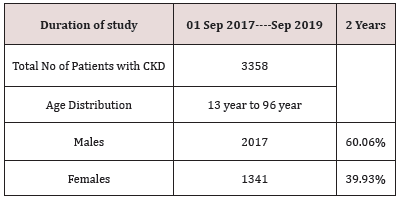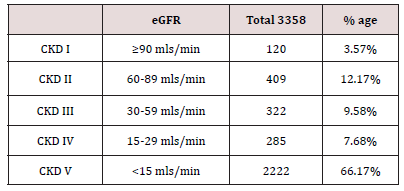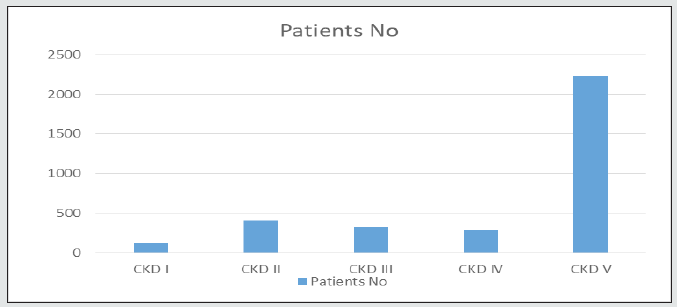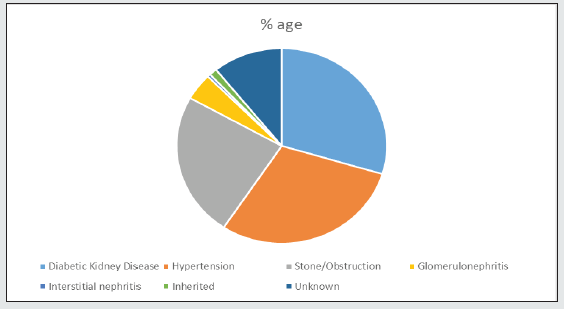
Lupine Publishers Group
Lupine Publishers
Menu
ISSN: 2641-1687
Review Article(ISSN: 2641-1687) 
Chronic Kidney Disease, Data from MIKD Volume 3 - Issue 2
M N Hashmi*, Khuram Bashir, Tanzeel Abbasi, Rashid Asghar, Shumaila Anwar and Aimon Riaz
- Department of Nephrology, Multan Institute of kidney diseases
Received:July 25, 2020; Published: August 03, 2021
Corresponding author: M N Hashmi, Department of Nephrology, Multan Institute of kidney disease, Pakistan
DOI: 10.32474/JUNS.2021.03.000156
Abstract
Chronic kidney disease (CKD) is a leaping up public health matter. It has an augmented effect on cardiovascular diseases and affects every system in body. In developed countries the extent of prevalence is available due to renal registries. In middle or low socio economic countries the proportion of this evolving health issue is not known. CKD is rising and a major contributor is soaring number of diabetes mellitus worldwide. Other significant addition in this cohort of CKD is by rising numbers of obese and hypertensive patients. In order to curtail this rising health matter immediate and intense measures both at preventive and curative levels are required.
Aim: Due to lack of formal renal registry we wanted to see spectrum of chronic kidney disease (CKD) in our catchment area and at what CKD stage they present to tertiary care hospital.
Methods: All patients who presented to Emergency department of Multan Institute of kidney disease from 01 Sep 2017 till Sep 2019 data were evaluated. Record of Emergency department patients were taken from electronic system of our hospital. Some patients had multiple visits and we took first visits kidney function in our analysis. eGFR was calculated from serum creatinine with help of CKD-EPI equation.
Results: Total 4303 patients were included in study. Males were 60% and females 40%. Age range from 13 years to 96 year old. 945 patients were excluded as they were not falling in chronic kidney disease category. Remaining 3358 patients had chronic kidney disease. Sub-analysis according to CKD stage showed 66.17% patients presented at CKD stage V.
Conclusion: Kidney disease is rising globally. Countries where renal registries are established provide incidence of chronic kidney disease ranging from 10 to 15%. Still a lot of countries worldwide do not have established system of data collection so true incidence is not established. Our work is first of its kind reported from this area. Drastic preventive strategies are need of time from health budget planners.
Introduction
Multan Institute of kidney diseases is a tertiary care nephrology and urology hospital located in Multan (Largest city) in South Punjab, Pakistan. Catchment area include Multan division, Dera ghazi khan division and Bahawalpur division. According to last census the total population of these 3 divisions is just over 34 million. All patients who presented to Emergency department of our institute from 01 September 2017 till 01 September 2019 were taken from electronic medical record of hospital.
Inclusion & Exclusion Criteria
Total number of patients in our data are 4303. Patients from Age 13 year and above were taken in study. Less than age 13 were not included. Maximum age recorded was 96 year old. In case of multiple visits to Emergency department by same patient, only first presentation kidney functions were included in study and subsequent visits kidney function were excluded. 467 patients had normal kidney functions, normal urinalysis and no structural abnormality on renal imaging and were excluded from interpretation. 478 patients were found to have acute kidney injury as per acute kidney injury network (AKIN) classification. These patients were also excluded from analysis. Rest of the patients (n=3358) had chronic kidney disease [Table 1].
Kidney Function Measurement (eGFR)
Serum Creatinine was taken to measure estimated glomerular filtration rate (eGFR). Various methods of eGFR calculation are available, including the Cockcroft-Gault equation, MDRD (Modification of Diet in Renal Disease) Study equation, and the CKD-EPI (Chronic Kidney Disease Epidemiology Collaboration) equation. We took CKD-EPI for measuring eGFR. Patients were divided in CKD stages from 1 to 5.
CKD Stages and Prevalence
Total 3358 patients were identified with chronic kidney disease. Majority (n=2222) of patients presented when eGFR was <15mls/min for the first time to tertiary care facility. CKD stages with number of patients in each group are in following Table 2 [Figure 1].
Causes of CKD
We analyzed our data to look into etiologies of chronic kidney disease. It showed 30 % patients had diabetic kidney disease and same proportion were hypertensive nephropathy patients. Next in line was obstructive nephropathy with 23.85%. Glomerulonephritis was about 4.5% and roughly 10% patients cause was not established as they presented late. Inherited diseases were just over 1% and interstitial nephritis was just 0.47% [Table 3]. Among the patient cohort diabetic kidney disease was separated based on presence of diabetes mellitus and one of the criteria (proteinuria, normal size kidneys, diabetic retinopathy on fundoscopy or >5 years duration of diabetes mellitus). Nearly 30% of total patients had diabetic kidney disease and more than 2/3rd of them had CKD-5 on presentation. A detailed analysis of CKD stages of diabetic group is in following table [Table 4] [Figure 2].
Discussion
Chronic kidney disease is rising worldwide. It has big impact on health economics [1,2]. Developed countries have registries showing its prevalence which helps in health budget planning. Unfortunately under developed countries lack such planning. In Pakistan recently a national renal registry has started working and will give informative statistics regarding renal disease spectrum. This will help in health management planning and focusing on areas where rampant growing renal issues are focused.
Reviewing published data spectrum of renal disease is variable in different geographical areas [3, 4]. Ethnicity, dietary habits, use of herbal medicines, low birth weight & climate all have been postulated as contributing factors in prevalence of chronic kidney disease. According to a Meta-analysis, chronic kidney disease has prevalence of 11% to 13% globally [5]. In Pakistan studies published on chronic kidney disease prevalence are usually from tertiary hospital or region based [6]. Tertiary care centers are in urban cities so there is no good data from rural areas. South Punjab of Pakistan majority comprise of rural area. According to last census the population of south Punjab 3 divisions (Multan, Bahawalpur and Dera Ghazi Khan) is 34 million [7]. This is the catchment area served by Multan institute of kidney disease (MIKD). MIKD is an emerging kidney institute in this area. We analyzed all patients who presented to Emergency department of our institute. We analyzed presentation creatinine and used CKD-EPI Creatinine Equation for eGFR calculation as recommended by the National Kidney Foundation [8]. Chronic kidney disease in Pakistan is on rise and presentation to specialist center is late. Majority of patients present with CKD-stage 5 requiring dialysis. Our hospital’s 2 year record tells us that 66.17% patients who attended Emergency room were at CKD-5 and majority required renal replacement therapy. Diabetic kidney disease was alarmingly on 29.66 %. Further sub analysis of diabetic kidney disease patients revealed that majority patients (72%) were at CKD stage 5 when presented to hospital emergency department. We labelled diabetic kidney disease based on presence of one of the following criteria’s (established diabetic retinopathy and/or micro albuminuria and/or long duration (>5 years) of diabetes mellitus). Further stage of CKD was established based on CKD-EPI calculation. Diabetes mellitus is at tremendous rate in Pakistan. International diabetes federation data reveals that 17.1% rising adult population of Pakistan is now living with diabetes mellitus [9]. With such enormous rise in diabetics in last decade, the burden of diabetic nephropathy is on rise too. In rural areas a lot of people are undiagnosed and usually present to health facility with end organ damage. According to systematic analytic study done in 2016 prevalence of diabetes mellitus in Pakistan is more in males as compared to females and more common in urban areas [10]. The rising burden of diabetes is imputed to environmental and emotional changes. The main contributors are sedentary lifestyle including internet and TV usage, caloric rich diets leading to increasing obesity. Pakistan with very high numbers of prevalent diabetes needs a cost-effective population based approach for screening [11]. Obstruction leading to chronic kidney disease was immensely at 23.85% in our studied population. Obstructive nephropathy due to stone is highly prevalent in this area and reviewing published data the number is almost 2-3 times in comparison to other parts of world. Nephrolithiasis is a highly prevalent disease worldwide with rates ranging from 7 to 13% in North America, 5–9% in Europe, and 1–5% in Asia. Due to high rates of new and recurrent stones, management of stones is expensive and the disease has a high level of acute and chronic morbidity [12]. Epidemiologic studies have demonstrated that the stone risk incidence increases with Body Mass Index, through multiple pathways. Metabolic syndrome and diabetes are associated with an increased renal stones disease incidence [13, 14]. There is a known high incidence of stone disease in Pakistan as this country belongs to the so-called stone belt [15]. In summing up our chronic kidney disease burden we have identified Diabetic kidney disease, Hypertension and Kidney stones as our bulk. This helps in health budget planning and preventive strategies to cut down disease load. Lack of renal registry in Pakistan has been emphasized [16]. Recently at national level Pakistan renal data system (PKDRS) is established and will provide data from all parts of country in coming years [17]. Curtailing diabetes will have significant reduction in diabetic kidney disease and strategies have been proposed. Creating multidisciplinary team, primary preventive strategies and nationwide diabetic care programme are proposed steps to deal this impending pandemic [18].
References
- Nugent RA, Fathima SF, Feigl AB, Chyung Dm (2011) The burden of chronic kidney disease on developing nations: a 21st century challenge in global health. Nephron Clin Pract 118(3): c269-277.
- Elshahat S, Cockwell P, Maxwell AP, Griffin M, O'Brien T, et al. (2020) The impact of chronic kidney disease on developed countries from a health economics perspective: A systematic scoping review. PLoS One 15(3): e0230512.
- Ozieh MN, Bishu KG, Walker RJ, Campbell JA, Egede LE (2016) Geographic variation in access among adults with kidney disease: evidence from medical expenditure panel survey, 2002-2011. BMC Health Serv Res 16(1): 585.
- McClellan AC, Plantinga L, McClellan WM (2012) Epidemiology, geography and chronic kidney disease. Curr Opin Nephrol Hypertens 21(3): 323-328.
- Hill NR, Fatoba ST, Oke JL, Hirst JA, O'Callaghan CA, et al. (2016) Global Prevalence of Chronic Kidney Disease - A Systematic Review and Meta-Analysis. PLoS One 11(7): e0158765.
- Jessani S, Bux R, Jafar TH (2014) Prevalence, determinants, and management of chronic kidney disease in Karachi, Pakistan - a community based cross-sectional study. BMC Nephrol 15: 90.
- Wikipedia contributors. Punjab, Pakistan [Internet]. Wikipedia, The Free Encyclopedia; 2021 Apr 15, 05:56 UTC [cited 2021 Apr 16].
- Levey AS, Stevens LA (2010) Estimating GFR using the CKD Epidemiology Collaboration (CKD-EPI) creatinine equation: more accurate GFR estimates, lower CKD prevalence estimates, and better risk predictions. Am J Kidney Dis 55(4): 622-627.
- diabetesatlas.org.(9th edition)
- Basit A, Fawwad A, Baqa K (2019) Pakistan and diabetes-A country on the edge. Diabetes Res Clin Pract 147: 166-168.
- Meo SA, Zia I, Bukhari IA, Arain SA (2016) Type 2 diabetes mellitus in Pakistan: Current prevalence and future forecast. J Pak Med Assoc 66(12): 1637-1642.
- Sorokin I, Mamoulakis C, Miyazawa K, Rodgers A, Talati J, et al. (2017) Epidemiology of stone disease across the world. World J Urol 35(9): 1301-1320.
- Carbone A, Al Salhi Y, Tasca A, Palleschi G, Fuschi A, et al. (2018) Obesity and kidney stone disease: a systematic review. Minerva Urol Nefrol 70(4): 393-400.
- Asplin JR (2009) Obesity and urolithiasis. Adv Chronic Kidney Dis 16(1): 11-20.
- Talati J, Khan F, Drago H (1997) Epidemiology of urolithiasis in Pakistan. in: Talati J, et al. (eds.) The management of lithiasis. London: Kiuwer Academic PubI pp. 21-33.
- Abid A, Abid H, Jamil A (2020) Need for a Central Renal Registry in Pakistan. Ther Apher Dial 24(4): 461.
- https://pkrds.com/about.html
- Basit A, Fawwad A, Siddiqui SA, Baqa K (2018) Current management strategies to target the increasing incidence of diabetes within Pakistan. Diabetes Metab Syndr Obes 12: 85-96.

Top Editors
-

Mark E Smith
Bio chemistry
University of Texas Medical Branch, USA -

Lawrence A Presley
Department of Criminal Justice
Liberty University, USA -

Thomas W Miller
Department of Psychiatry
University of Kentucky, USA -

Gjumrakch Aliev
Department of Medicine
Gally International Biomedical Research & Consulting LLC, USA -

Christopher Bryant
Department of Urbanisation and Agricultural
Montreal university, USA -

Robert William Frare
Oral & Maxillofacial Pathology
New York University, USA -

Rudolph Modesto Navari
Gastroenterology and Hepatology
University of Alabama, UK -

Andrew Hague
Department of Medicine
Universities of Bradford, UK -

George Gregory Buttigieg
Maltese College of Obstetrics and Gynaecology, Europe -

Chen-Hsiung Yeh
Oncology
Circulogene Theranostics, England -
.png)
Emilio Bucio-Carrillo
Radiation Chemistry
National University of Mexico, USA -
.jpg)
Casey J Grenier
Analytical Chemistry
Wentworth Institute of Technology, USA -
Hany Atalah
Minimally Invasive Surgery
Mercer University school of Medicine, USA -

Abu-Hussein Muhamad
Pediatric Dentistry
University of Athens , Greece

The annual scholar awards from Lupine Publishers honor a selected number Read More...










